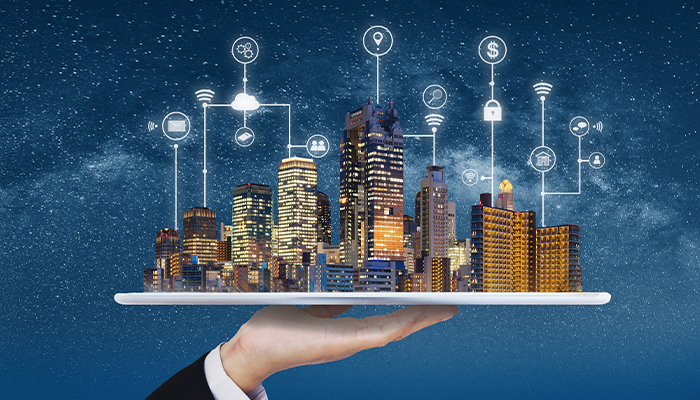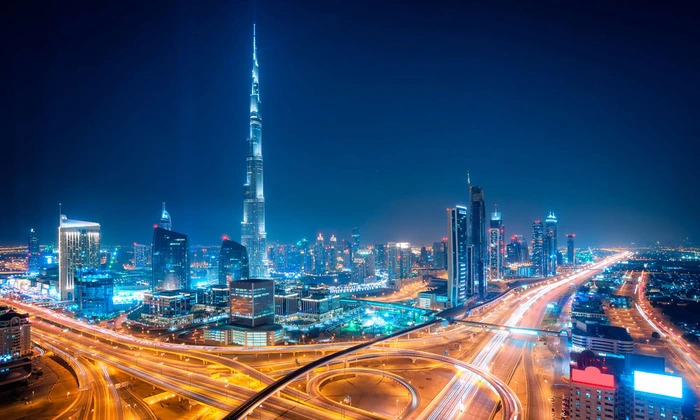15
+
YEARS OF
EXPERIENCE
1000
+
SUCCESSFUL
Projects
80
+
Satisfied
Clients

In the heart of the Middle East, Dubai stands as a testament to the transformative power of technology. Over the past few decades, this desert metropolis has undergone a remarkable evolution to emerge a global business hub teeming with technological innovation.
But Dubai’s transformation – and the innovation yet to come – is made possible only with the support of a dedicated and experienced IT sector. From visionary government initiatives to cutting-edge infrastructure development, Dubai’s commitment to technological excellence is underpinned by robust IT support, the common thread that enables sustained growth.
In this article, we’ll explore Dubai’s rise to a technological powerhouse and the pivotal role that IT has played in the technological renaissance.
1970s: Laying the Foundations
Technological Landscape
Dubai and the UAE as a whole was a vastly different place in the 1970s. To put it into perspective, the seven emirates only unified to form the United Arab Emirates in late 1971! Marking a historic moment of collaboration and shared vision among the emirates, the establishment of the UAE secured political and economic stability for the decades ahead.
The emergence of the UAE as a global player wasn’t apparent in the 1970s. Primarily reliant on traditional industries like fishing and pearling, urban development was in its early stages. The skyline of Dubai was markedly different than the one we know today: instead, Dubai’s landscape was marked by vast stretches of sand, traditional markets, and a lifestyle centered around the sea.
The role of IT
As you might imagine in a predominantly traditional economy, the initial IT landscape was fairly limited. Basic IT infrastructure was introduced. Early computerization efforts were modest. IT initiatives focused primarily on enhancing administrative processes and communication within the government sectors.
Although technology’s role was nascent compared to today, the foundational steps taken in the 1970s set the trajectory for the UAEs technological evolution. And although perhaps late to the game, the UAE was able to learn from other countries’ trial and errors to establish an IT foundation in only a decade – a fraction of the timeframe taken by many developed nations.
1980s: The Oil Boom
Technological Landscape
The 1980s marked a transformative period for Dubai as the oil boom fueled unprecedented economic prosperity. The discovery and exploitation of oil reserves fundamentally altered the economic landscape of the UAE, particularly Abu Dhabi and Dubai: the newfound oil wealth allowed the emirates to diversify their economies and invest in infrastructure projects.
The increased revenues provided the financial means to invest in education, healthcare, and various industries, transforming the UAE into a thriving and cosmopolitan hub with a diversified economy. It’s in the 80s that the UAE emerged as a global economic player, with the oil boom facilitating modernization and urban development. Dubai alone saw the emergence of iconic structures like the Dubai World Trade Center, signifying the city’s aspirations for a modern identity, and bustling commercial districts began to take shape.
The role of IT
In tandem with Dubai’s economic diversification, the 1980s saw the city take its first steps in information technology. Basic computerization initiatives gained traction, particularly within various government sectors, marking a notable departure from manual processes towards more efficient and streamlined administrative functions.
On the whole, IT remained in its infancy, with initial forays during this period remaining tentative. Yet these steps solidified the foundations for a digital future, laying the groundwork for subsequent advancements.
1990s: Telecommunications Expansion
Technological Landscape
The 1990s witnessed Dubai’s continued economic expansion, marked by an increasingly diversified portfolio that included trade, finance, and tourism. The city’s skyline continued its upward trajectory, adorned with architectural marvels like the Dubai Creek Golf & Yacht Club and the Emirates Towers.
In particular, the telecommunications industry witnessed a transformative phase. The primary provider of telecommunications services in the UAE, Etisalat, underwent a period of rapid growth and expansion. Meanwhile, liberalisation in the sector paved the way for increased competition and innovations, with services becoming more widely accessible to the general population.
Additionally, The 1990s saw substantial investments in fiber optic networks, which significantly improved the speed and efficiency of communication. This aligned with the UAE’s commitment to establish international connectivity to facilitate global communication and trade. Improved submarine cable systems and satellite links were developed, connecting the country to the global telecommunications network and enhancing its status as a key player in the Middle East.
The role of IT
As telecommunications expanded, so too did IT Support. IT support teams were at the forefront of deploying and maintaining the intricate web of hardware and software components essential for seamless connectivity.
From network deployment to system integration, these professionals ensured the compatibility of various technological elements. Moreover, as digital communication became more prevalent, IT support specialists were instrumental in implementing robust security measures, safeguarding networks from emerging cyber threats and ensuring the integrity of sensitive information traversing these communication channels.
Beyond the technical aspects, IT support was integral in offering practical assistance to end-users and telecommunications professionals alike. Their role extended to troubleshooting issues, addressing connectivity challenges, and providing essential technical support to businesses and residents relying on these burgeoning telecommunications services. Their expertise not only facilitated the exponential growth of the UAE’s telecommunications infrastructure but also ensured its reliability, security, and alignment with global standards.







2000s – E-Government Initiatives and IT Investments
The onset of the 21st century marked a pivotal era for UAE’s technological landscape, with a notable focus on E-Government initiatives and substantial investments in IT. As Dubai continued its economic diversification, the city’s skyline evolved with iconic structures like the Burj Khalifa, symbolizing Dubai’s ascent as a global metropolis.
Technological Landscape
Building upon the foundations laid in the preceding decades, the government continued its commitment to digital transformation, shaping the nation into a global technology hub. E-Government initiatives evolved to encompass a wide array of services, making the citizen experience more seamless and efficient.
One notable initiative during this era was the Smart Dubai project. Launched in 2013, this comprehensive initiative aimed to harness technology to enhance the quality of life for residents and visitors alike.
The integration of cutting-edge technologies like artificial intelligence, blockchain, and the Internet of Things (IoT) into various aspects of city living solidified Dubai’s status as a Smart City. The city’s infrastructure became increasingly interconnected, with initiatives such as the Dubai Data Initiative facilitating the sharing of data across government entities, fostering innovation and efficiency.
At the same time, substantial investments in sectors like healthcare, education, and transportation contributed to the overall digital transformation. Initiatives like the Dubai Health Strategy 2021 and Smart Education were emblematic of the government’s commitment to leveraging technology for the betterment of key sectors, while the transportation sector witnessed the advent of futuristic projects like the Dubai Autonomous Transportation Strategy.
The role of IT
In the realm of IT, these initiatives translated into a burgeoning demand for advanced support services. The complexity of interconnected systems, the influx of data, and the integration of emerging technologies necessitated robust IT support structures. This era witnessed a shift towards more specialized support teams capable of managing intricate systems, ensuring cybersecurity, and providing timely assistance to end-users navigating the evolving digital landscape.
Cybersecurity became a focal point, and IT support specialists were at the forefront of implementing robust measures to safeguard sensitive data and protect against emerging cyber threats.
2010s – Smart City Vision Takes Shape
Technological Landscape
The accelerating pace of change doesn’t slow down in the 2010s. This was another pivotal decade for the UAE as Dubai embarked on a visionary journey to transform into a smart city – a city that uses technology to make city life better for everyone.
Urban infrastructure developed beyond traditional parameters. Smart electrical grids used technology and two-way communication to optimise energy usage, while smart transportation systems included features like traffic lights that adjusted based on the number of cars on the road and buses that follow optimal routes using real-time data. In this decade, Dubai achieved what other countries have sought to replicate since: a seamlessly connected urban environment that responds dynamically to the needs of its inhabitants.
The 2010s also witnessed a paradigm shift in telecommunications with the widespread adoption of 5G technology. The UAE invested heavily in building a robust 5G infrastructure. This not only revolutionized internet speeds but also laid the foundation for the Internet of Things (IoT), enabling a myriad of devices to communicate and collaborate in real-time.

answer time
satisfaction
score
on initial call
same business
day
IT Role
In this era of technological advancement, the role of IT professionals expanded to encompass the intricate demands of smart city development. From implementing and managing IoT devices to ensuring the security of interconnected systems, IT specialists became essential architects of the Smart City vision. Their responsibilities included overseeing the deployment of smart technologies, managing data analytics for informed decision-making, and enhancing cybersecurity protocols to safeguard critical infrastructure. IT professionals were (and are!) invaluable to the creation of more efficient, responsive, and connected urban landscapes which ultimately enhance the quality of life for residents and foster sustainable urban development.

The future of Innovation in Smart City Evolution
The momentum of technological progress has continued into the mid-2020s as the UAE continues its journey towards smart city excellence. Building on the transformative initiatives of the previous decade, the focus remains on enhancing urban living through advanced technology. Smart infrastructure continues to evolve, with an increased emphasis on sustainability and resilience. Urban spaces are becoming more interconnected, with IoT-enabled sensors proliferating to gather real-time data for informed decision-making.
Telecommunications infrastructure, particularly the 5G network, continues to be a key driver of progress. The investment in a robust 5G foundation not only sustains lightning-fast internet speeds but also fuels the expansion of the Internet of Things (IoT), enabling seamless communication among a diverse array of devices. As the cityscape becomes more technologically integrated, the next five years are poised to witness further advancements in connectivity, setting the stage for unprecedented levels of innovation and efficiency.
The role of Information Technology (IT) professionals remains indispensable in this era of technological evolution. Their responsibilities encompass deploying and managing IoT devices, ensuring the security of interconnected systems, and refining data analytics for more sophisticated decision-making. As architects of the smart city vision, IT specialists continue to play a crucial role in shaping urban landscapes that are not only efficient and responsive but also sustainable, enhancing the overall quality of life for residents in the ever-evolving smart cities of the UAE.

